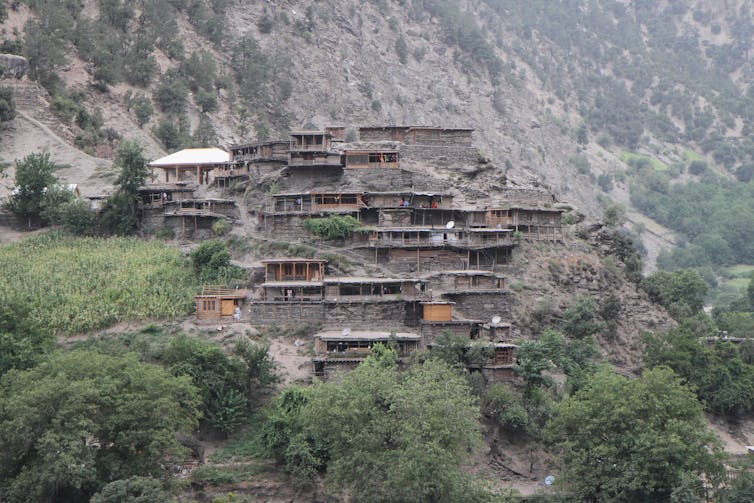“Abujie Baya, ta’biat prúst?”
I open my eyes to the sound of a voice as the twin-engine Pakistan Airlines propeller aircraft flies through the Hindu Kush mountain range, west of the mighty Himalayas. We are cruising at 27,000 feet, but the mountains around us appear worryingly close and the turbulence has woken me up during a 22-hour trip to the most remote place in Pakistan – the Kalash valleys of the Khyber-Pakhtunkhwa region.
To my left, a distraught female passenger is quietly praying. On my immediate right sits my guide, translator and friend Taleem Khan, a member of the polytheistic Kalash tribe which numbers around 3,500 people. This was the man who was speaking to me as I was waking up. He leans over again and asks, this time in English: “Good morning, brother. Are you well?”
“Prúst,” (I’m well) I reply, as I become more aware of my surroundings.

It doesn’t seem like the plane is descending; rather, it feels as if the ground is coming up to meet us. And after the plane has hit the runway, and the passengers have disembarked, the chief of the Chitral Police Station is there to greet us. We are assigned a police escort for our protection (four officers operating in two shifts), as there are very real threats to researchers and journalists in this part of the world.

Only then can we embark on the second stage of our trip: a two-hour jeep ride to the Kalash valleys on a gravel road which has tall mountains on one side, and a 200ft drop into the Bumburet river on the other. The intense colours and vivacity of the location must be lived to be understood.
The objective of this research trip, conducted by the Durham University Music and Science Lab, is to discover how the emotional perception of music may be influenced by the listeners’ cultural background, and to examine whether there are any universal aspects to emotions conveyed by music. To help us understand this question, we wanted to find people who had not been exposed to western culture.
The villages that are to be our base of operations are spread across three valleys on the border between north-west Pakistan and Afghanistan. They are home to a number of tribes, though both nationally and internationally they are known as the Kalash valleys (named after the Kalash tribe). Despite their relatively small population, their unique customs, polytheistic religion, rituals and music set them apart from their neighbours.

In the field
I have conducted research in locations like Papua New Guinea, Japan and Greece. The truth is fieldwork is often expensive, potentially dangerous and sometimes even life-threatening.
But difficult as it is to conduct experiments when faced with linguistic and cultural barriers, the lack of a stable electricity supply to charge our batteries would be among the hardest obstacles for us to overcome on this trip. Data can only be collected with the assistance and willingness of local people. The people we met literally went the extra mile for us (actually, an extra 16 miles) so we could recharge our equipment at the closest town with power. There is little infrastructure in this region of Pakistan. The local hydro-electric power plant provides 200W for each household at night, but it is prone to malfunctions due to flotsam after each rainfall, causing it to stop operating every second day.
Once we overcame the technical issues, we were ready to begin our musical investigation. When we listen to music, we rely heavily on our memory of the music we’ve heard throughout our lives. People around the world use different types of music for different purposes. And cultures have their own established ways of expressing themes and emotions through music, just as they have developed preferences for certain musical harmonies. Cultural traditions shape which musical harmonies convey happiness and – up to a point – how much harmonic dissonance is appreciated. Think, for example, of the happy mood of The Beatles’ Here Comes the Sun and compare it to the ominous harshness of Bernard Herrmann’s score for the infamous shower scene in Hitchcock’s Psycho.

This story is part of Conversation Insights
The Insights team generates long-form journalism and is working with academics from different backgrounds who have been engaged in projects to tackle societal and scientific challenges.
So, as our research aimed to discover how the emotional perception of music may be influenced by the listeners’ cultural background, our first objective was to locate participants who were not overwhelmingly exposed to western music. This is easier said than done, due to the overarching effect of globalisation and the influence western musical styles have on world culture. A good starting point was to look for places without a stable electricity supply and very few radio stations. That would usually mean poor or no internet connection with limited access to online music platforms – or, indeed, any other means of accessing global music.
One benefit of our chosen location was that the surrounding culture was not western-oriented, but rather in a different cultural sphere altogether. Punjabi culture is the mainstream in Pakistan, as the Punjabi are the largest ethnic group. But the Khowari culture dominates in the Kalash Valleys. Less than 2% speak Urdu, Pakistan’s lingua franca, as their mother tongue. The Kho people (a neighbouring tribe to the Kalash), number about 300,000 and were part of the Kingdom of Chitral, a princely state which was first part of the British Raj, and then of the Islamic Republic of Pakistan until 1969. The western world is seen by the communities there as something “different”, “foreign” and “not our own”.

The second aim was to locate people whose own music consists of an established, native performance tradition in which the expression of emotion through music is done in a comparable manner to the west. That’s because, even though we were trying to escape the influence of western music on local musical practices, it was nevertheless important that our participants understood that music could potentially convey different emotions.
Finally, we needed a location where our questions could be put in a way that would enable participants from different cultures to assess emotional expression in both western and non-western music.
For the Kalash, music is not a pastime; it is a cultural identifier. It is an inseparable aspect of both ritual and non-ritual practice, of birth and of life. When someone dies, they are sent off to the sounds of music and dancing, as their life story and deeds are retold.

Meanwhile, the Kho people view music as one of the “polite” and refined arts. They use it to highlight the best aspects of their poetry. Their evening gatherings, typically held after dark in the homes of prominent members of the community, are comparable to salon gatherings in Enlightenment Europe, in which music, poetry and even the nature of the act and experience of thought are discussed. I was often left to marvel at how regularly men, who seemingly could bend steel with their piercing gaze, were moved to tears by a simple melody, a verse, or the silence which followed when a particular piece of music had just ended.

It was also important to find people who understood the concept of harmonic consonance and dissonance – that is, the relative attractiveness and unattractiveness of harmonies. This is something which can be easily done by observing whether local musical practices include multiple, simultaneous voices singing together one or more melodic lines. After running our experiments with British participants, we came to the Kalash and Kho communities to see how non-western populations perceive these same harmonies.
Our task was simple: expose our participants from these remote tribes to voice and music recordings which varied in emotional intensity and context, as well as some artificial music samples we had put together.
Major and minor
A mode is the language or vocabulary that a piece of music is written in, while a chord is a set of pitches which sound together. The two most common modes in western music are major and minor. Here Comes the Sun by The Beatles is a song in a major scale, using only major chords, while Call Out My Name by the Weeknd is a song in a minor scale, which uses only minor chords. In western music, the major scale is usually associated with joy and happiness, while the minor scale is often associated with sadness.
Right away we found that people from the two tribes were reacting to major and minor modes in a completely different manner to our UK participants. Our voice recordings, in Urdu and German (a language very few here would be familiar with), were perfectly understood in terms of their emotional context and were rated accordingly. But it was less than clear cut when we started introducing the musical stimuli, as major and minor chords did not seem to get the same type of emotional reaction from the tribes in northwest Pakistan as they do in the west.
We began by playing them music from their own culture and asked them to rate it in terms of its emotional context; a task which they performed excellently. Then we exposed them to music which they had never heard before, ranging from West Coast Jazz and classical music to Moroccan Tuareg music and Eurovision pop songs.
While commonalities certainly exist – after all, no army marches to war singing softly, and no parent screams their children to sleep – the differences were astounding. How could it be that Rossini’s humorous comic operas, which have been bringing laughter and joy to western audiences for almost 200 years, were seen by our Kho and Kalash participants to convey less happiness than 1980s speed metal?
We were always aware that the information our participants provided us with had to be placed in context. We needed to get an insider perspective on their train of thought regarding the perceived emotions.

Essentially, we were trying to understand the reasons behind their choices and ratings. After countless repetitions of our experiments and procedures and making sure that our participants had understood the tasks that we were asking them to do, the possibility started to emerge that they simply did not prefer the consonance of the most common western harmonies.
Not only that, but they would go so far as to dismiss it as sounding “foreign”. Indeed, a recurring trope when responding to the major chord was that it was “strange” and “unnatural”, like “European music”. That it was “not our music”.
What is natural and what is cultural?
Once back from the field, our research team met up and together with my colleagues Dr Imre Lahdelma and Professor Tuomas Eerola we started interpreting the data and double checking the preliminary results by putting them through extensive quality checks and number crunching with rigorous statistical tests. Our report on the perception of single chords shows how the Khalash and Kho tribes perceived the major chord as unpleasant and negative, and the minor chord as pleasant and positive.
To our astonishment, the only thing the western and the non-western responses had in common was the universal aversion to highly dissonant chords. The finding of a lack of preference for consonant harmonies is in line with previous cross-cultural research investigating how consonance and dissonance are perceived among the Tsimané, an indigenous population living in the Amazon rainforest of Bolivia with limited exposure to western culture. Notably, however, the experiment conducted on the Tsimané did not include highly dissonant harmonies in the stimuli. So the study’s conclusion of an indifference to both consonance and dissonance might have been premature in the light of our own findings.

Listen to George Athanasopoulos talk about these research findings on The Conversation Weekly podcast.
When it comes to emotional perception in music, it is apparent that a large amount of human emotions can be communicated across cultures at least on a basic level of recognition. Listeners who are familiar with a specific musical culture have a clear advantage over those unfamiliar with it – especially when it comes to understanding the emotional connotations of the music.
But our results demonstrated that the harmonic background of a melody also plays a very important role in how it is emotionally perceived. See, for example, Victor Borge’s Beethoven variation on the melody of Happy Birthday, which on its own is associated with joy, but when the harmonic background and mode changes the piece is given an entirely different mood.
Then there is something we call “acoustic roughness”, which also seems to play an important role in harmony perception – even across cultures. Roughness denotes the sound quality that arises when musical pitches are so close together that the ear cannot fully resolve them. This unpleasant sound sensation is what Bernard Herrmann so masterfully uses in the aforementioned shower scene in Psycho. This acoustic roughness phenomenon has a biologically determined cause in how the inner ear functions and its perception is likely to be common to all humans.
According to our findings, harmonisations of melodies that are high in roughness are perceived to convey more energy and dominance – even when listeners have never heard similar music before. This attribute has an affect on how music is emotionally perceived, particularly when listeners lack any western associations between specific music genres and their connotations.
For example, the Bach chorale harmonisation in major mode of the simple melody below was perceived as conveying happiness only to our British participants. Our Kalash and Kho participants did not perceive this particular style to convey happiness to a greater degree than other harmonisations.
The wholetone harmonisation below, on the other hand, was perceived by all listeners – western and non-western alike – to be highly energetic and dominant in relation to the other styles. Energy, in this context, refers to how music may be perceived to be active and “awake”, while dominance relates to how powerful and imposing a piece of music is perceived to be.
Carl Orff’s O Fortuna is a good example of a highly energetic and dominant piece of music for a western listener, while a soft lullaby by Johannes Brahms would not be ranked high in terms of dominance or energy. At the same time, we noted that anger correlated particularly well with high levels of roughness across all groups and for all types of real (for example, the Heavy Metal stimuli we used) or artificial music (such as the wholetone harmonisation below) that the participants were exposed to.
So, our results show both with single, isolated chords and with longer harmonisations that the preference for consonance and the major-happy, minor-sad distinction seems to be culturally dependent. These results are striking in the light of tradition handed down from generation to generation in music theory and research. Western music theory has assumed that because we perceive certain harmonies as pleasant or cheerful this mode of perception must be governed by some universal law of nature, and this line of thinking persists even in contemporary scholarship.
Indeed, the prominent 18th century music theorist and composer Jean-Philippe Rameau advocated that the major chord is the “perfect” chord, while the later music theorist and critic Heinrich Schenker concluded that the major is “natural” as opposed to the “artificial” minor.
But years of research evidence now shows that it is safe to assume that the previous conclusions of the “naturalness” of harmony perception were uninformed assumptions, and failed even to attempt to take into account how non-western populations perceive western music and harmony.
Just as in language we have letters that build up words and sentences, so in music we have modes. The mode is the vocabulary of a particular melody. One erroneous assumption is that music consists of only the major and minor mode, as these are largely prevalent in western mainstream pop music.
In the music of the region where we conducted our research, there are a number of different, additional modes which provide a wide range of shades and grades of emotion, whose connotation may change not only by core musical parameters such as tempo or loudness, but also by a variety of extra-musical parameters (performance setting, identity, age and gender of the musicians).
For example, a video of the late Dr Lloyd Miller playing a piano tuned in the Persian Segah dastgah mode shows how so many other modes are available to express emotion. The major and minor mode conventions that we consider as established in western tonal music are but one possibility in a specific cultural framework. They are not a universal norm.
Why is this important?
Research has the potential to uncover how we live and interact with music, and what it does to us and for us. It is one of the elements that makes the human experience more whole. Whatever exceptions exist, they are enforced and not spontaneous, and music, in some form, is present in all human cultures. The more we investigate music around the world and how it affects people, the more we learn about ourselves as a species and what makes us feel.
Our findings provide insights, not only into intriguing cultural variations regarding how music is perceived across cultures, but also how we respond to music from cultures which are not our own. Can we not appreciate the beauty of a melody from a different culture, even if we are ignorant to the meaning of its lyrics? There are more things that connect us through music than set us apart.

When it comes to musical practices, cultural norms can appear strange when viewed from an outsider’s perspective. For example, we observed a Kalash funeral where there was lots of fast-paced music and highly-energetic dancing. A western listener might wonder how it is possible to dance with such vivacity to music which is fast, rough and atonal – at a funeral.
But at the same time, a Kalash observer might marvel at the sombreness and quietness of a western funeral: was the deceased a person of so little importance that no sacrifices, honorary poems, praise songs and loud music and dancing were performed in their memory? As we assess the data captured in the field a world away from our own, we become more aware of the way music shapes the stories of the people who make it, and how it is shaped by culture itself.
After we had said our goodbyes to our Kalash and Kho hosts, we boarded a truck, drove over the dangerous Lowari Pass from Chitral to Dir, and then travelled to Islamabad and on to Europe. And throughout the trip, I had the words of a Khowari song in my mind: “The old path, I burn it, it is warm like my hands. In the young world, you will find me.”
The more we learn about music’s rich variations, the more we learn about ourselves.

For you: more from our Insights series:
WitchTok: the rise of the occult on social media has eerie parallels with the 16th century
The Prestige: the real-life warring Victorian magicians who inspired the film
‘We have nothing left’ – the catastrophic consequences of criminalising livelihoods in west Africa
To hear about new Insights articles, join the hundreds of thousands of people who value The Conversation’s evidence-based news. Subscribe to our newsletter.

